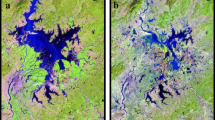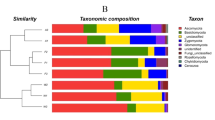Abstract
Soil degradation, a growing problem in the arid and semi-arid area, significantly influences wetland dynamics and nutrient cycling. Using tussock wetlands as objectives, this study aims to explain the effects of long-term soil degradation on plant diversity and dominant species and identify the impacts of long-term soil degradation, growing month, species, and their interactions on plant nutrient stoichiometry in Momoge wetland. Field experiments were undertaken to explore the responses of plant diversity and nutrient to soil degradation in Momoge wetland. The relationships between plant nutrient and soil physicochemical properties were examined by canonical correspondence analysis (CCA). Soil nutrient significantly decreased in degraded tussock wetlands. Long-term soil degradation altered plant diversity and the important values of dominant species. Plant nutrient indicated that the effects of soil degradation on plant carbon, nitrogen, and phosphorus were not significant at the single species level. Furthermore, plant stoichiometric patterns were not sensitive to soil degradation. However, both the N/P ratio in soil and plants showed a nitrogen limitation for the plant growth in wetlands. The CCA indicated that the soil total nitrogen and electrical conductivity were the primary factors affecting the cycle of biogenic elements in tussock wetlands. Results highlight the differences in biogenic elements in wetland soil and vegetation and identify the significant effects of soil degradation on the wetland plants. These findings suggest that the variation of nutrient availability and electronic conductivity affects the growth of the wetland species.



Similar content being viewed by others
References
Benvenuti G, Bosma R, Cuaresma M, Janssen M, Barbosa MJ, Wijffels RH (2015) Selecting microalgae with high lipid productivity and photosynthetic activity under nitrogen starvation. J Appl Phycol 27:1425–1431
Branco P, Egas M, Elser JJ, Huisman J (2018) Eco-evolutionary dynamics of ecological stoichiometry in plankton communities. Am Nat 192:E1–E20
Chen Y, Li Y, Sun P, Chen G, Xin J (2017) Interactive effects of salt and alkali stresses on growth, physiological responses and nutrient (N, P) removal performance of Ruppia maritima. Ecol Eng 104:177–183
Choudhury MI, McKie BG, Hallin S, Ecke F (2018) Mixtures of macrophyte growth forms promote nitrogen cycling in wetlands. Sci Total Environ 635:1436–1443
Dijkstra FA, Pendall E, Morgan JA, Blumenthal DM, Carrillo Y, LeCain DR, Follett RF, Williams DG (2012) Climate change alters stoichiometry of phosphorus and nitrogen in a semiarid grassland. New Phytol 196:807–815
Elser JJ, Dobberfuhl DR, MacKay NA, Schampel JH (1996) Organism size, life history, and N:P stoichiometry. Bioscience. 46:674–684
Elser JJ, Fagan WF, Kerkhoff AJ, Swenson NG, Enquist BJ (2010) Biological stoichiometry of plant production: metabolism, scaling and ecological response to global change. New Phytol 186:593–608
Guan B, Yu J, Wang X, Fu Y, Kan X, Han G, Lu Z (2011) Physiological responses of halophyte Suaeda salsa to water table and salt stresses in coastal wetland of Yellow River Delta. Clean-Soil Air Water 39:1029–1035
Guo X, Chen L, Zheng R, Zhang K, Qiu Y, Yue H (2019) Differences in soil nitrogen availability and transformation in relation to land use in the Napahai wetland, Southwest China. J Soil Sci Plant Nutr:1–6
Gusewell S (2004) N:P ratios in terrestrial plants: variation and functional significance. New Phytol 164:243–266
Gusewell S, Koerselman M (2002) Variation in nitrogen and phosphorus concentrations of wetland plants. Perspect Plant Ecol 5:37–61
Jiang, M,, Lu, X.G., Xu, L.S., Liu, J.P., Yin, S.B. 2005. Estimation on anti-erosion bnefit of wetland in Momoge natural reserve. Chinese Journal of Northeast Forestry University. 33, 67–68,69
Jiménez-Ballesta R, García-Navarro FJ, Martín-Consuegra SB, De los Reyes CP, Ortíz-Villajos JÁA, San Miguel MF (2018) The impact of the storage of nutrients and other trace elements on the degradation of a wetland. Int J Environ Res 12:87–100
Juergens MT, Deshpande RR, Lucker BF, Park JJ, Wang HX, Gargouri M, Holguin FO, Disbrow B, Schaub T, Skepper JN, Kramer DM, Gang DR, Hicks LM, Shachar-Hill Y (2015) The regulation of photosynthetic structure and function during nitrogen deprivation in Chlamydomonas reinhardtii. Plant Physiol 167:558–573
Khaledian Y, Kiani F, Ebrahimi S, Brevik EC, Aitkenhead-Peterson J (2017) Assessment and monitoring of soil degradation during land use change using multivariate analysis. Land Degrad Dev 28(1):128–141
Knoop H, Steuer R (2015) A computational analysis of stoichiometric constraints and trade-offs in cyanobacterial biofuel production. Front Bioeng Biotechnol 3:1–15
Koerselman W, Meuleman AFM (1996) The vegetation N:P ratio: a new tool to detect the nature of nutrient limitation. J Appl Ecol 33:1441–1450
Lawrence BA, Zedler JB (2011) Formation of tussocks by sedges: effects of hydroperiod and nutrients. Ecol Appl 21:1745–1759
Lawrence BA, Zedler JB (2013) Carbon storage by Carex stricta tussocks: a restorable ecosystem service? Wetlands. 33:483–493
Lawrence BA, Fahey TJ, Zedler JB (2013) Root dynamics of Carex stricta-dominated tussock meadows. Plant Soil 364:325–339
Li L, Zerbe S, Han W, Niels T, Li W, He P, Schmitt AO, Liu Y, Ji C (2014) Nitrogen and phosphorus stoichiometry of common reed (Phragmites australis) and its relationship to nutrient availability in northern China. Aquat Bot 112:84–90
Liu F, Liu Y, Wang G, Song Y, Liu Q, Li D, Mao P, Zhang H (2015) Seasonal variations of C: N: P stoichiometry and their trade-offs in different organs of Suaeda salsa in coastal wetland of Yellow River Delta, China. PLoS One 10:1–15
Liu B, Jiang M, Tong S, Zhang W, Wu H, Liu Y, Lu X (2016) Differential flooding impacts on Echinochloa caudata and Scirpus planiculmis: implications for weed control in wetlands. Wetlands. 36:979–984
Liu Y, Ding Z, Bachofen C, Lou Y, Jiang M, Tang X, Lu X, Buchmann N (2018) The effect of saline-alkaline and water stresses on water use efficiency and standing biomass of Phragmites australis and Bolboschoenus planiculmis. Sci Total Environ 644:207–216
Lou Y, Zhao K, Wang G, Jiang M, Lu X, Rydin H (2015) Long-term changes in marsh vegetation in Sanjiang plain, Northeast China. J Veg Sci 26:643–650
Lou Y, Gao C, Pan Y, Xue Z, Liu Y, Tang Z, Jiang M, Lu X, Rydin H (2018) Niche modelling of marsh plants based on occurrence and abundance data. Sci Total Environ 616:198–207
Luo XZ, Zhu T, Sun GY (2002) Wetland restoration and reconstruction in Da’an paleochannel of Songnen plain. Chinese Acta Ecologica Sinica 23:244–250
Ma M, Baskin CC, Yu K, Ma Z, Du G (2017) Wetland drying indirectly influences plant community and seed bank diversity through soil pH. Ecol Indic 80:186–195
Mao R, Chen HM, Zhang XH, Shi FX, Song CC (2016) Effects of P addition on plant C:N:P stoichiometry in an N-limited temperate wetland of Northeast China. Sci Total Environ 559:1–6
Meunier CL, Boersma M, El-Sabaawi R, Halvorson HM, Herstoff EM, Van de Waal DB, Vogt RJ, Litchma E (2017) From elements to function: toward unifying ecological stoichiometry and trait-based ecology. Front. Environ. Sci 5:1–15
Oldeman, L. R., Hakkeling, R. T. A., Sombroek, W. G. 2017. World map of the status of human-induced soil degradation: an explanatory note
Pan X, Zhang D, Liu Q (2006) Interactive factors leading to dying-off Carex tato in Momoge wetland polluted by crude oil, Western Jilin, China. Chemosphere. 65:1772–1777
Qiao Y, Yang W, Zhao Y, Jeelani N, Xu L, Zhao H, Zhang Y, An S, Leng X (2018) How Spartina alterniflora adapts to a new environment created by embankment reclamation through C-N-P stoichiometry in the coastal wetlands of eastern China. Mar Freshw Res 69:823–832
Questad EJ, Foster BL (2007) Vole disturbances and plant diversity in a grassland metacommunity. Oecologia. 153:341–351
Rong Q, Liu J, Cai Y, Lu Z, Yue W, Xia J (2015) Leaf carbon, nitrogen and phosphorus stoichiometry of Tamarix chinensis Lour. in the Laizhou Bay coastal wetland, China. Ecol Eng 76:57–65
Tian G (1998) Effect of soil degradation on leaf decomposition and nutrient release under humid tropical conditions. Soil Sci 163:897–906
Wang XY, Feng J, Zhao JM (2010) Effects of crude oil residuals on soil chemical properties in oil sites, Momoge wetland, China. Environ Monit Assess 161:271–280
Wang WQ, Sardans J, Wang C, Zeng C, Tong C, Asensio D, Peñuelas J (2015) Ecological stoichiometry of C, N, and P of invasive Phragmites australis and native Cyperus malaccensis species in the Minjiang River tidal estuarine wetlands of China. Plant Ecol 216:809–822
Wang M, Wang G, Wang S, Jiang M (2018a) Structure and richness of Carex meyeriana Tussocks in peatlands of northeastern China. Wetlands 38:15–23
Wang Z, Wu Z, Wang Y, Yu D (2018b) Variations in species-level N: P stoichiometry of charophytes and aquatic angiosperms on the Tibetan plateau. Front Plant Sci 9:1–15
Wang X, Zhang D, Qi Q, Tong S, An Y, Lu X, Liu Y (2019) The restoration feasibility of degraded Carex tussock in soda-salinization area in arid region. Ecol Indic 98:131–136
Yan Z, Hou X, Han W, Ma S, Shen H, Guo Y, Fang J (2018) Effects of nitrogen and phosphorus supply on stoichiometry of six elements in leaves of Arabidopsis thaliana. Ann Bot 20:1–10
Yu Q, Elser JJ, He N, Wu H, Chen Q, Zhang G, Han X (2011) Stoichiometric homeostasis of vascular plants in the Inner Mongolia grassland. Oecologia 166:1–10
Yu Q, Wilcox K, Pierre KL, Knapp AK, Han X, Smith MD (2015) Stoichiometric homeostasis predicts plant species dominance, temporal stability, and responses to global change. Ecology 96:2328–2335
Zhang Y (2010) The research for mutual effects between ryegrass and soil contaminated with crude petroleum. Northeast Normal University
Zhang D, Qi Q, Tong S, Zhang Z, Wang X, An Y, Pan Y (2018) Effect of alternative dry-wet shiftinging on eco-physiological characteristics of Carex schmidtii tussocks. Chin J Ecol 37:43–49
Zhang D, Qi Q, Wang X, Tong S, Lv X, An Y, Zhu X (2019a) Physiological responses of Carex schmidtii Meinsh to alternating flooding-drought conditions in the Momoge wetland, Northeast China. Aquat Bot 153:33–39
Zhang D, Tong S, Qi Q, Zhang M, An Y, Wang X, Lu X (2019b) Effects of drought and re-flooding on growth and photosynthesis of Carex schmidtii Meinsh: implication for tussock restoration. Ecol Indic 103:134–144
Zhao K (1999) Mires in Chinese. Science Press, Beijing
Zhao Q, Bai J, Lu Q, Zhang G (2017) Effects of salinity on dynamics of soil carbon in degraded coastal wetlands: implications on wetland restoration. Phys Chem Earth 97:12–18
Funding
This research was supported by the National Natural Science Foundation of China (41871101), Science and Technology Development Project of Jilin Province (No. 20190201115JC; No. 20170520081JH), the National Key R&D Program of China (2016YFC0500403), and China Postdoctoral Science Foundation (No. 20150010).
Author information
Authors and Affiliations
Corresponding authors
Ethics declarations
Conflict of Interest
The authors declare that they have no conflict of interest.
Additional information
Publisher’s note
Springer Nature remains neutral with regard to jurisdictional claims in published maps and institutional affiliations.
Rights and permissions
About this article
Cite this article
Zhang, D., Qi, Q., Tong, S. et al. Soil Degradation Effects on Plant Diversity and Nutrient in Tussock Meadow Wetlands. J Soil Sci Plant Nutr 19, 535–544 (2019). https://doi.org/10.1007/s42729-019-00052-9
Received:
Accepted:
Published:
Issue Date:
DOI: https://doi.org/10.1007/s42729-019-00052-9




